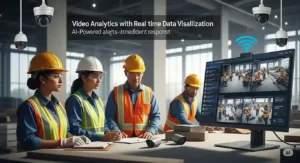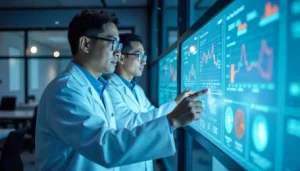Introduction
Running a restaurant successfully requires effective management and decision-making. One crucial aspect that can greatly contribute to the success of a restaurant is the utilization of real-time data and analytics through an Enterprise Resource Planning (ERP) system. In this article, we will explore the significance of real-time data and analytics in restaurant management and how an ERP system can enhance operational efficiency, customer satisfaction, and overall profitability.
What is Real-Time Data and Analytics?
Real-time data refers to information that is collected, processed, and analyzed instantly as events occur. It provides up-to-the-minute insights and enables immediate decision-making. Analytics, on the other hand, involves the interpretation and extraction of meaningful patterns, trends, and correlations from data. Together, real-time data and analytics offer valuable insights that can drive informed decisions in restaurant management.
The Role of Real-Time Data and Analytics in Restaurant Management
Enhancing Operational Efficiency
Real-time data and analytics enable restaurant managers to monitor and analyze various operational aspects, such as table turnover rates, order processing times, and kitchen efficiency. By having access to real-time data, managers can identify bottlenecks, streamline processes, and make timely adjustments to optimize efficiency and reduce costs.
Improving Customer Satisfaction
Real-time data and analytics play a vital role in enhancing customer satisfaction. By analyzing customer feedback, preferences, and behavior patterns, restaurant owners can personalize the dining experience, offer targeted promotions, and ensure timely service. Real-time data also enables managers to promptly address any issues or complaints, leading to improved customer loyalty and positive word-of-mouth.
Optimizing Inventory Management
Effective inventory management is crucial for maintaining optimal stock levels, reducing waste, and preventing shortages. Real-time data and analytics provide accurate insights into inventory levels, demand patterns, and supplier performance. With this information, restaurant managers can make data-driven decisions regarding procurement, storage, and menu planning, ensuring efficient inventory management and cost control.
Streamlining Employee Scheduling and Performance
Real-time data and analytics facilitate optimized employee scheduling and performance monitoring. By analyzing historical data and real-time information on employee availability, skill sets, and performance metrics, managers can create efficient schedules that align with demand. Additionally, real-time analytics enable managers to identify top-performing employees and provide them with recognition and rewards, fostering a positive work culture.
Analyzing Sales and Revenue Patterns
Real-time data and analytics allow restaurant managers to track sales and revenue patterns in real-time. By monitoring key performance indicators (KPIs) such as average check size, sales per hour, and revenue by menu item, managers can identify trends, adjust pricing strategies, and make data-backed decisions to maximize profitability.
Monitoring and Enhancing Marketing Efforts
Real-time data and analytics provide valuable insights into marketing efforts. By analyzing customer demographics, preferences, and response to marketing campaigns, restaurant owners can tailor their marketing strategies for targeted promotions and advertisements. Real-time data also enables managers to evaluate the effectiveness of marketing campaigns in real-time, allowing for timely adjustments to optimize results.
Gaining a Competitive Edge
Utilizing real-time data and analytics gives restaurants a competitive edge in the industry. By leveraging data-driven insights, restaurants can stay ahead of market trends, identify emerging opportunities, and proactively respond to changing customer preferences. Real-time analytics also enable quick adaptation to market conditions, enhancing the restaurant’s ability to outperform competitors.
Ensuring Data Security and Privacy
While real-time data and analytics offer numerous benefits, it is essential to prioritize data security and privacy. Restaurant managers should implement robust data protection measures and adhere to relevant regulations to safeguard customer information and business data. Encryption, access controls, and regular data backups are crucial components of a comprehensive data security strategy.
Challenges and Considerations in Implementing an ERP System
While the benefits of an ERP system in restaurant management are evident, there are some challenges and considerations to keep in mind. Integration with existing systems, employee training, and potential disruptions during implementation are factors that need careful planning and execution. However, with the right implementation strategy and change management processes in place, the rewards of an ERP system outweigh the challenges.
The Benefits of Implementing an ERP System
To harness the full potential of real-time data and analytics, restaurants can implement an ERP system. An ERP system integrates various business functions, such as inventory management, sales, finance, and human resources, into a centralized platform. The benefits of implementing an ERP system in restaurant management include:
- Streamlined processes and increased operational efficiency.
- Improved communication and collaboration between different departments.
- Enhanced data accuracy and consistency.
- Better forecasting and planning capabilities.
- Simplified compliance with regulatory requirements.
- Increased scalability and adaptability to changing business needs.
Conclusion
Real-time data and analytics are invaluable tools for effective restaurant management. By leveraging real-time insights, restaurant owners and managers can optimize operations, enhance customer satisfaction, and drive profitability. The implementation of an ERP system further amplifies these benefits by providing a centralized platform for data integration and analysis. Embracing the power of real-time data and analytics is a strategic move that enables restaurants to thrive in a competitive industry.
FAQs
Q1: How does real-time data improve employee scheduling? Real-time data allows managers to assess employee availability, skill sets, and performance metrics, enabling optimized employee scheduling that aligns with demand and maximizes operational efficiency.
Q2: Can real-time data help restaurants with inventory management? Absolutely. Real-time data provides accurate insights into inventory levels, demand patterns, and supplier performance, enabling restaurants to optimize inventory management, reduce waste, and prevent shortages.
Q3: What role does real-time data play in marketing efforts? Real-time data helps restaurants analyze customer demographics, preferences, and response to marketing campaigns. This information enables targeted promotions and advertisements and allows for timely adjustments to marketing strategies.
Q4: Is data security a concern when utilizing real-time data and analytics? Yes, data security should be a top priority. Restaurants must implement robust data protection measures, including encryption, access controls, and regular data backups, to ensure the security and privacy of customer information and business data.
Q5: How can an ERP system benefit restaurant management? An ERP system integrates various business functions into a centralized platform, streamlining processes, enhancing communication and collaboration, improving data accuracy, and providing better forecasting and planning capabilities. It simplifies compliance and offers scalability and adaptability to changing business needs.





